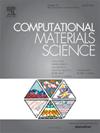Microscale deformation, residual stress and fracture behavior of additively manufactured alpha-Ti: Combined crystal plasticity and phase-field damage modeling
IF 3.1
3区 材料科学
Q2 MATERIALS SCIENCE, MULTIDISCIPLINARY
引用次数: 0
Abstract
Additively manufactured (AM) titanium is a promising material for aerospace, marine engineering and medical equipment because of the flexibility in the manufactured shape and because of their light weight, high strength and corrosion resistance. Plastic deformation and fracture at the microscale have not been widely investigated because of the complexity of carrying out in-situ experiments. In this study, a combined crystal plasticity and phase-field fracture constitutive model for hexagonal close-packed crystal structures is developed, which can simulate the fracture behavior of the alpha phase of AM titanium alloys. An anisotropic thermal expansion model is established to capture the residual stress during the cooling process and its effect on subsequent plastic deformation and fracture. The simulated strain to failure is calibrated with experimental data. The model exhibits strong anisotropy, which agrees with experimental results. Based on the developed model, the influence of microstructural features on the fracture behavior of alpha-Ti is systematically investigated. The findings reveal that grain shape and orientation significantly affect the strain to failure and crack propagation paths of alpha-Ti. Specifically, turns out to be responsible for strain localization, and fracture nucleation and propagation The presence of a substantial amount of elongated columnar grains in AM materials is identified as a major factor contributing to anisotropy. The strain failure appears to be higher when load is applied along the maximum principal axis of the grains. The introduction of residual stress increases the final strain to failure in the model; this is interpreted as an acculation of compressive stress in elongated grains with the c axis approximately perpendicular to the load. Furthermore, by altering the local stress distribution, residual stress influences the crack propagation paths. This work provides useful insights into the crack initiation and propagation mechanisms of AM alpha-Ti. The simulation results can also provide guidance for process design such as adjusting scan direction and speed to optimize the microstructural characteristics and, consequently, improve the macroscopic mechanical properties of the material.

求助全文
约1分钟内获得全文
求助全文
来源期刊

Computational Materials Science
工程技术-材料科学:综合
CiteScore
6.50
自引率
6.10%
发文量
665
审稿时长
26 days
期刊介绍:
The goal of Computational Materials Science is to report on results that provide new or unique insights into, or significantly expand our understanding of, the properties of materials or phenomena associated with their design, synthesis, processing, characterization, and utilization. To be relevant to the journal, the results should be applied or applicable to specific material systems that are discussed within the submission.
 求助内容:
求助内容: 应助结果提醒方式:
应助结果提醒方式:


